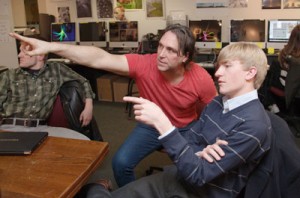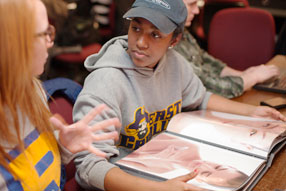 Capturing lipstick as it drips, the gleam of broken eggs, or cockroaches swarming a sneaker-strewn table—and making them look beautiful—requires particular photography skills.
Capturing lipstick as it drips, the gleam of broken eggs, or cockroaches swarming a sneaker-strewn table—and making them look beautiful—requires particular photography skills.
On February 19, as part of the ongoing Photographers’ Lecture Series, commercial and fine art photographer Bill Diodato named some of those skills: patience, preparation, and the ability to stay true to yourself.
Mr. Diodato, who has worked in New York City for over two decades, said that satisfying the demands of magazine editors and fashion clients of the highest caliber took both creativity—and the ability to withstand the tedium of shooting close-ups, one after the other, just to get the right dusting of shadow across an eyelid.
“In the commercial world, beauty photography is about the ability to sell cosmetics,” Mr. Diodato said. “It’s about making skin look gorgeous with the cosmetics a company provides you.”
Rather than capturing a fleeting moment, as a journalism or nature photographer might do, Mr. Diodato said he was tasked with creating a picture that was perfect, right down the last detail. The secret to that perfection, he said, was in the set-up.
“A photo sells the idea of a specific product,” Mr. Diodato said. “It’s more about preparation and production. The photo is done by the time I show up on the job.”
For the worlds of beauty (where the idea is to sell makeup), and fashion (which is all about the clothes), a photographer is often tasked with coming up with a narrative to inform a series of photos. As he flipped through slides of his work, Mr. Diodato described some of his favorite fashion stories: a woman’s face being transformed by splashes of powdered makeup like fall foliage; an Alice in Wonderland theme featuring lingerie; a shoe shoot on a beach where models had valves as though they were inflatable; a story that juxtaposed scanty swimsuits with gnarly sports injuries.
“In the studio, you have to tell a story,” Mr. Diotato said. “Or it’s just a picture of a pretty person, sitting on a background.”
Perhaps the best illustration of the type of patience—and post-production—that goes into such work came when Mr. Diodato flipped to a photo of a sliced orange, gleaming with dribbles of chocolate. Since melting chocolate hardens quickly, and the client wanted drops in certain places, Mr. Diodato spent a 12-hour day (and dozens of oranges) photographing splashes and trickles on the fruit. A digital editor then spent another day stitching half a dozen photos together to create the perfect final image.
“In the end the photographer’s job is to make sure their client is taken care of,” Mr. Diodato said. “It’s your job to entertain them. So you find yourself trying to move them in some way.”
As the lecture was winding to a close, Mr. Diodato turned to images of his fine art work: portraits of a pierced and tattooed man sitting on a background so vibrantly red it was almost tactile; and haunting photos of the Oregon State Mental Hospital he published as a monograph in Care of Ward 81. In the end, though, and despite the successes and acclaim he has achieved, Mr. Diodato took a modest view of his photography.
“I don’t look at commercial art as having fans,” Mr. Diodato said. “Many people will disagree with that, but we all have jobs to do and we all want to do our job. When you walk away, and you’ve treated someone fairly and you felt like you did what you need to do, then you can hold your head up.”
“Out of the many schools that I have been to, I have rarely seen the sparkle and passion that these kids showed. It’s great to see the future photographers of this industry. The facilities were amazing. These kids are very, very lucky, “ he added.
The Photographers’ Lecture Series continues this year with Claire Rosen on Thursday, March 28; Ron Wyatt on Thursday, April 11, and filmmakers Michael Zide and Braden Chattman on Tuesday, April 23.

